Introduction
After the Internet, the Internet of Things (IoT) is a major development trend. The release of various smart hardware and the continuous updates in network technology are rapidly ushering in an era of “everything connected.” For developers, understanding the major IoT development platforms is essential to making strides in this booming field. Today, I will take you through an overview of eight major IoT platforms in China.
Baido IoT Hub
Baido IoT Hub is a fully managed cloud service that facilitates bidirectional communication between devices and the cloud, supporting massive data collection, monitoring, fault prediction, and five other IoT scenarios.
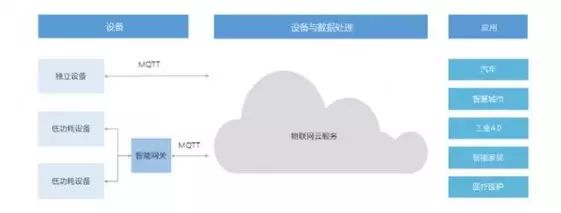
Baido IoT Hub Architecture
Baido IoT Hub supports the MQTT communication protocol and various development languages, including C, C#, Python, and CLI command-line tools, making it compatible with mainstream hardware devices. It ensures data security through device-level authentication, policy authorization, bidirectional secure connections, and SS transmission, while integrating with Baido’s big data services to provide data analysis services.
The process to access Baido IoT Hub is: Register an open cloud account → Create an instance endpoint → Create a thing → Create a principal → Create a policy → Configure the MQTT client. Currently, Baido IoT Hub is free of charge.
Aliyun IoT Suite
Aliyun IoT Suite helps developers build secure and high-performance data channels, facilitating bidirectional communication between terminals (such as sensors, actuators, embedded devices, or smart appliances) and the cloud. It supports five major application scenarios: device-to-cloud, cloud-to-device, asynchronous requests between devices and the cloud, and interconnectivity between devices from different manufacturers.
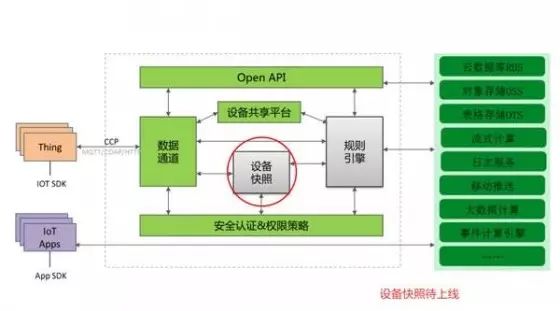
Aliyun IoT Suite Architecture
Users can implement Pub/Sub asynchronous communication based on the CCP protocol or use remote procedure call (RPC) communication mode for device-to-cloud communication. Additionally, users can connect to Aliyun IoT using the open-source MQTT protocol to achieve Pub/Sub asynchronous communication.
In terms of security, the IoT suite provides multiple protections to ensure device-cloud security. In terms of performance, the IoT suite can support hundreds of millions of devices with long connections and millions of concurrent messages. The IoT suite also offers a one-stop managed service, covering data collection, computation, and storage, allowing users to configure rules on the web without needing to purchase servers or deploy distributed architectures.
QQ IoT
The QQ IoT platform aims to provide core capabilities such as the QQ account system, friend relationship chain, QQ messaging channel, and audio-video services to partners in fields like wearable devices, smart homes, smart vehicles, and traditional hardware, enabling interaction between users and devices, devices and devices, and devices and services. By leveraging Tencent QQ’s vast client base and cloud services, it helps traditional industries achieve internet integration on a larger scale.
Currently, QQ IoT devices include five major categories: audio-video products, communication interaction products, data collection products, and wireless control products. The functionalities range from quick IoT access, APP development and maintenance, messaging/file communication capabilities, to advanced capabilities such as business custom cloud (statistics, analysis, storage, etc.) and integrated identity recognition capabilities (not yet launched).
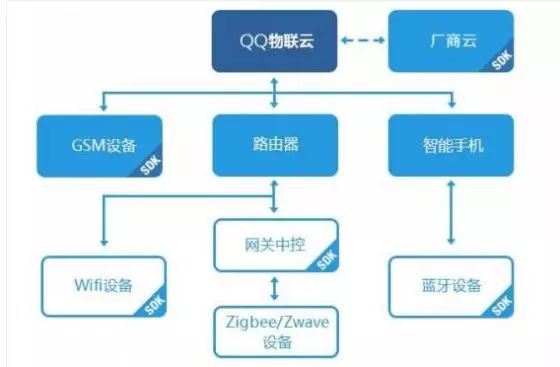
QQ IoT Architecture
Currently, QQ IoT is presented in the form of a lightweight APP. When a user binds a smart device, the first interface they enter in the “My Devices” list is the lightweight APP for that device. The lightweight APP has a front-end JS interface deviceAPI for controlling devices, with basic capabilities such as sending and receiving messages, as well as unique capabilities like video calls, image uploads, and sharing.
JD Micro Link
JD Micro Link is an intelligent platform created by JD for future smart living, aimed at helping smart hardware manufacturers create better smart hardware products and providing consumers with a one-stop smart product experience. It features APP connectivity, smart home, and smart health functionalities.
When developers develop on the JD Micro Link platform, they can collaborate with module and chip manufacturers that have partnerships with JD. Product firmware needs to integrate the JD Micro Link JoyLink protocol, and JD currently provides the SDK and debugging tools for the JoyLink protocol.
After the R&D phase, developers need to register the products that connect with JD Micro Link in the developer center, which involves product entry. The product entry process is: Apply to become a developer → Create a product → Enter product functions → Html5 configuration → Product release. Html5 development must comply with JD Micro Link’s interaction and development specifications.
Currently, JD Micro Link is open to third-party developers, exposing JD Micro Link data through the JOS (JD Open Service) interface. Developers can access JD’s intelligent cloud open services and develop third-party applications with functionalities similar to Micro Link using existing interfaces. Users can use third-party developer-created apps to access the device list bound to JD Micro Link and control authorized devices without using JD Micro Link.
Gizwits IoT Cloud Service Platform and Smart Hardware Self-Development Platform
The Gizwits platform is an open platform dedicated to IoT and smart hardware cloud services. The platform provides capabilities covering the entire lifecycle of smart hardware access and operation management, from product definition, device-side development and debugging, application development, product testing, to operation management.
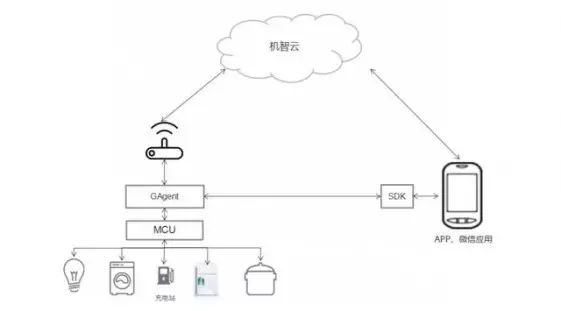
Gizwits IoT Cloud Service Platform Architecture
The Gizwits platform provides developers with self-service smart hardware development tools and open cloud services. Through user-friendly tools and continuously enhanced SDK and API service capabilities, it minimizes the technical barriers to IoT hardware development, reduces R&D costs, and speeds up product launch for developers, helping them upgrade hardware intelligence and better connect and serve end consumers.
The Gizwits platform features IoT PaaS services, enterprise SaaS services, and GDMS functionalities, along with self-service development tools, GoKit development kits, and developer services.
Qingke Cloud FogCloud
Qingke Cloud FogCloud provides developers with convenient smart hardware access services, along with powerful cloud services including product/APP management, messaging channels, and data storage. It offers rich cloud functionalities, allowing developers to focus on top-level applications without expending effort on backend processing, underlying construction, protocol conversion, etc.
The interaction process between devices or apps connected to Qingke Cloud FogCloud and the cloud includes registration, binding, and communication. The registration and binding processes use FogCloud’s Open API, while communication uses FogCloud’s MQTT server.
Ablecloud IoT Self-Development and Big Data Cloud Platform
Ablecloud IoT Self-Development and Big Data Cloud Platform is aimed at IoT hardware manufacturers, providing device networking and management, remote viewing and control, customized cloud function development, and massive hardware data storage and analysis infrastructure to accelerate the intelligent networking of hardware.
Ablecloud IoT Self-Development and Big Data Cloud Platform includes an integrated cloud service development engine, IoT functional components and solution supermarket, and big data analysis engine.
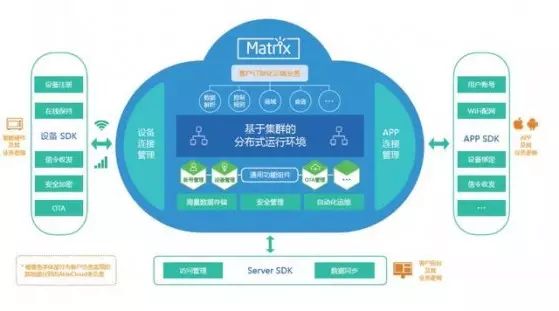
Ablecloud IoT Self-Development and Big Data Cloud Platform Architecture
Ablecloud IoT Self-Development and Big Data Cloud Platform provides networking firmware, solving connection management for tens of millions of devices, direct connection and other exceptional backup solutions, and employs highly optimized multi-layer encryption algorithms at the network communication layer to ensure the security of devices and messages.
China Mobile IoT Open Platform OneNet
OneNET is an open and win-win device cloud platform built by China Mobile IoT Co., Ltd., providing simple cloud access, storage, computing, and display for various cross-platform IoT applications and industry solutions, quickly creating IoT product applications and reducing development costs. It features IoT PaaS foundational capabilities, SaaS business services, IoT data cloud, and a developer community.

OneNet Architecture
The China Mobile IoT Open Platform features stream analysis, device cloud management, multi-protocol configuration, rapid generation of lightweight applications, APIs, and online debugging functionalities. The access platform process is: Login registration → Create product → Add device → Add data stream → View data → Create application.
Devices can connect to the platform via private protocols and standard protocols. RGMP (remote gateway management protocol) is the platform’s private protocol, and the platform does not provide protocol message descriptions. Standard protocols include HTTP, EDP, MQTT, MODBUS, JT/T808, and the platform provides message description documents for each protocol.
Editor: Qiu Nan
Source: China Cloud Computing
Voice of the Internet of Things
Human Network, Internet of Things, Value Network
WeChat ID: aiotvoice
Weibo: Voice of the Internet of Things
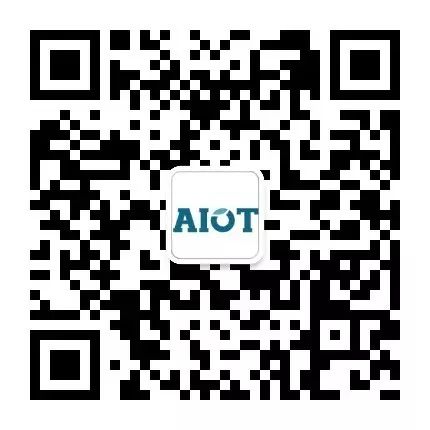
Long press to recognize the QR code and follow us
Cooperation inquiries: 4000609292
Submission email: [email protected]
